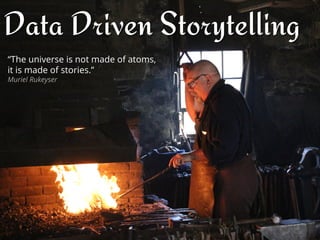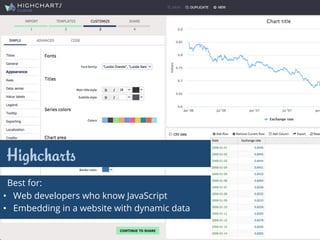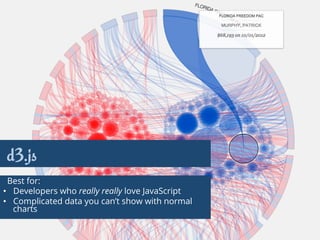Data driven storytelling
- 1. Data Driven Storytelling ŌĆ£The universe is not made of atoms, it is made of stories.ŌĆØ Muriel Rukeyser
- 4. Humans are wired for storytelling Stories are how we imagine possibilities, encode our values, and teach lessons to the next generation. Stories impart facts, opinions, judgments, and emotions. Stories have a unique power to both inform and persuade.
- 5. Why Data?
- 6. We live in a results-driven world Nonpro’¼üts are expected to be ŌĆ£run like a businessŌĆØ Foundations make ŌĆ£investmentsŌĆØ, not grants
- 7. Let me tell you a storyŌĆ”
- 8. Elements of a good story Se#ng ┬ĀWhere ┬Āare ┬Āwe? ┬Ā ┬Ā ┬ĀWhy ┬Āare ┬Āwe ┬Āhere? ┬Ā Characters ┬ĀProtagonists ┬Ā& ┬ĀAntagonists ┬Ā ┬ĀCon’¼éict ┬Ā& ┬ĀPoten8al ┬Ā ┬Ā Plot ┬ĀBeginning, ┬ĀMiddle, ┬ĀEnd ┬Ā ┬ĀBackstory, ┬ĀAc8on, ┬ĀResolu8on ┬Ā ┬Ā Detail ┬ĀDetail, ┬Ānot ┬Ādigression ┬Ā
- 9. Whose story is it? Do you want people to explore and come to their own conclusions? Or you have a message you want them to take away?
- 10. How about the data?
- 11. Tableau Public Best for: ŌĆóŌĆ»Making & sharing a quick story ŌĆóŌĆ»Data you donŌĆÖt mind making public
- 12. #MakeoverMonday
- 13. Highcharts Best for: ŌĆóŌĆ» Web developers who know JavaScript ŌĆóŌĆ» Embedding in a website with dynamic data
- 14. d3.js Best for: ŌĆóŌĆ» Developers who really really love JavaScript ŌĆóŌĆ» Complicated data you canŌĆÖt show with normal charts
- 15. More examples if we have timeŌĆ” ŌĆóŌĆ» Charts ŌĆōŌĆ» http://viz.healthmetricsandevaluation.org/gbd-compare/ ŌĆóŌĆ» Maps ŌĆōŌĆ» http://pooreconomics.com/data/country/home ŌĆóŌĆ» Interactive ŌĆōŌĆ» http://foods.bridgingthegapresearch.org ŌĆóŌĆ» Immersive Presentation ŌĆōŌĆ» http://rwjf.org/maketobaccohistory
- 16. Data-Driven Storytelling In Ten Easy Steps! 1.ŌĆ» Draft your story 2.ŌĆ» Gather & process the data 3.ŌĆ» Select a presentation style (Classic, funky, map, infographic; interactive vs static) and a tool (O’¼Ć the shelf? Custom built?) 4.ŌĆ» Load the data & create your visualization 5.ŌĆ» Add your narrative 6.ŌĆ» Make it beautiful 7.ŌĆ» Test it and make it better 8.ŌĆ» Release it & promote it 9.ŌĆ» Keep the data updated (Daily? Yearly? Real-time?) 10.ŌĆ» Impact the world
- 17. Workshop Time
- 18. Your Story ŌĆóŌĆ» Who are your characters ŌĆō your heroes and villains? ŌĆóŌĆ» WhoŌĆÖs your audience? Do they know your characters?
- 19. Your Data ŌĆóŌĆ» What data will you need to tell this story? ŌĆóŌĆ» Do you have it now, or can you easily acquire it? ŌĆóŌĆ» Will it need to be processed and analyzed, or just presented?
- 20. Your Stage ŌĆóŌĆ» How can you best reach your audience with this story? ŌĆōŌĆ»Your website? Social media? Email? Print? ŌĆóŌĆ» What do you want them to take away from your story, and what actions can they take? ŌĆóŌĆ» How will you measure the impact your story has?
- 22. Thanks for Listening! Nathan Gasser ngasser@rockriverstar.com Briana Morgan brianalmorgan@gmail.com





















